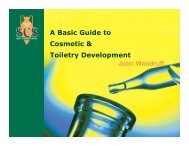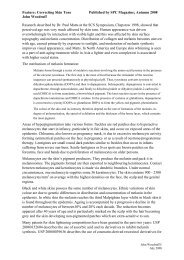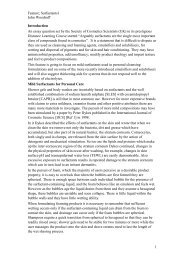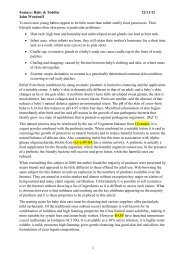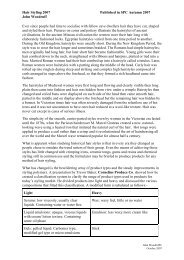Hair 2011.pdf - Creative Developments
Hair 2011.pdf - Creative Developments
Hair 2011.pdf - Creative Developments
Create successful ePaper yourself
Turn your PDF publications into a flip-book with our unique Google optimized e-Paper software.
Feature; <strong>Hair</strong> 2011<br />
John Woodruff<br />
Considering that the hair visible on human heads consists almost entirely of dead<br />
protein a disproportionate amount of time and income is spent looking after it. First it<br />
has to be cleaned, then disentangled and combed, two relatively simple processes that<br />
can be taken care of using a shampoo and a hair conditioner. It is then that matters<br />
become complicated with owners wanting to bleach, colour, straighten, style and<br />
otherwise maltreat the hair that they have, safe in the knowledge that it will continue<br />
to replace itself, until one day it is realised this is not happening anymore.<br />
On average each strand of hair grows 10.5mm per month, which over the whole<br />
head equates to 35m per day or 12.5km per year [Ref 1].<br />
<strong>Hair</strong> in good condition can absorb more than 30 % of its own weight of water.<br />
Blow-drying and oxidative stress lead to the formation of reactive oxygen species<br />
(ROS) which oxidize and degrade the proteins of the hair surface and thus affect<br />
the structure of the hair<br />
Washing hair with shampoo would seem to be a straightforward process but a glance<br />
along the relevant shelves in any major store or pharmacy reveals just how many<br />
apparently different products there are. A basic product comprising sodium laureth<br />
sulphate (SLES) with cocamidopropyl betaine (CAPB) in water will effectively clean<br />
hair and it is doubtful that any other combination of surfactants will be as cost<br />
effective as the SLES/CAPB combination. It gives rapid and copious foam; is easy to<br />
thicken and is almost colourless and odourless and for these reasons it is still the most<br />
common system to be found in mass market products.<br />
Adding botanical extracts makes the product easier to market and there are many<br />
ingredients available to further improve product characteristics however the starting<br />
point is to look at the surfactant system.<br />
Despite the effectiveness of the SLES/CAPB system for various reasons alternative<br />
combinations are sought after. Some consumer groups do not like ethoxylates; some<br />
don’t want sulphates; others would like to be thought natural and some would just like<br />
to stand out from the crowd. Alkyl polyglucosides did much to fill the gap, they are<br />
widely accepted as being “green” and there is plenty of advice on formulating with<br />
them available from their principal suppliers, Cognis (now BASF) and Evonik. Also<br />
Dow Chemicals has recently launched a 50% solution of decyl glucoside as Triton<br />
CG-50.<br />
Sulfosuccinates are produced by the EOC Group and Croda Europe and Croda also<br />
supplies sarcosinates. Acyl lactylates from R.I.T.A. have good foaming<br />
characteristics and are suggested for use with alkyl polyglucosides. Amphoterics are<br />
generally added to improve mildness to standard systems and typical examples are<br />
amphoacetates and amphopropionates available from Rhodia. There are glutamates<br />
from Ajinomoto; sugar-based anionic surfactants from Colonial and surfactants<br />
derived from vegetable proteins from Synerga.<br />
For those looking to be ever more natural there is Amaranth from Arch Personal<br />
Care, which is sodium cocoyl hydrolyzed amaranth protein and Synerga uses<br />
different mixtures of fatty acids and hydrolysed protein chains of different lengths to<br />
obtain anionic surfactants with detergent properties. Paroxite supplies a Quillaia<br />
saponaria extract with very good foaming properties and I.M.C.D. markets Zizyphus
Feature; <strong>Hair</strong> 2011<br />
John Woodruff<br />
joazerio bark extract from Soliance. Symrise offers Sapindus mukurossi peel extract,<br />
which is recommended for personal cleansing products including shower gels and<br />
shampoos.<br />
None of these surfactants can be considered new and most were described in greater<br />
detail in SPC September? 2008. More recent introductions include Liposine Glyglu/R<br />
from Biobasic Europe and available through Blagden in the UK. It is a lipo-amino<br />
acid obtained from the acylation of coconut fatty acids with amino acids from rice.<br />
The resultant lipo-amino acid complex may be substituted for the primary surfaceactive<br />
agent in a shampoo and the foam obtained is said to be creamy, fine and stable.<br />
The Liposine product brochure contains a foam stability test, the results of which<br />
show that the foaming properties of Liposine are comparable with SLES and sodium<br />
coceth sulphate, and that it is better than lauryl glucoside. It is also very mild and may<br />
be used with SLES to reduce its irritation scores.<br />
Amisafe AL-01 [NCI: Lauroyl arginine] from Ajinomoto is an amino acid based<br />
amphoteric surfactant derived from L-arginine and lauric acid. It is said to be ideal<br />
for very dry, damaged and unruly hair as it effectively binds to the hair to improve<br />
smoothness, hydration, shine and control. It is suitable for shampoos, conditioners and<br />
styling products with a recommended usage level of 0.2-5% in shampoos and 0.5-1%<br />
in hair conditioners and styling products.<br />
Cognis-BASF is known for providing optimum mixtures of ingredients to provide<br />
particular properties; its Lamesoft Care is a mixture of PEG-4 distearyl ether, sodium<br />
laureth sulfate, distearyl ether and dicaprylyl ether, which demonstrates particularly<br />
strong performance for conditioning and protection against hair breakage when used<br />
in a shampoo.<br />
Natural cleansing and foaming agents appeal to certain market niches and besides<br />
those previously mentioned Pacifique Sud offers Ginger Shampoo. It is a clear<br />
viscous juice found in the mature flower heads of Zingiber zerumbet. It is rich in<br />
natural surfactants and is said to leave the hair soft with exceptional shine. It may be<br />
used as it is or mixed into shampoos and conditioners as an additive.<br />
Known for its supply of glutamates and sarcosinates BC Cosmetics & Food uses<br />
various natural vegetable triglycerides to offer a number of amphoacetates under the<br />
generic INCI name Sodium triglyceride amphoacetates. The source materials include<br />
sweet almond, babussa, cotton, olive and argan oils.<br />
Argan oil is currently popular in hair and skin care products: it is pressed from the<br />
seeds of the Argania Spinosa tree and is composed primarily of unsaturated fatty acids<br />
and is rich in sterols. While its main use is in skin care Aldivia has argan oil as the<br />
basis of Viatenza Argan PO6 and PE8, which are argan oil polyglyceryl esters and<br />
argan oil PEG-8 esters respectively. These amphiphilic compounds are recommended<br />
as secondary surfactants and solubilising agents for shampoos and are available<br />
through Surfachem in the UK.<br />
Aldivia also promote the use of oat beta-glucan as Avenacare. Through the formation<br />
of a natural film, Avenacare improves the tensile strength of hair, adding body and<br />
repairing damage caused by the elements or the overuse of chemicals in other hair<br />
care products.
Feature; <strong>Hair</strong> 2011<br />
John Woodruff<br />
Utilising carefully selected combinations it is possible to formulate shampoos that will<br />
appeal to whichever market share is the target but additives are needed to further<br />
differentiate the shampoo compositions.<br />
Based on natural materials Phytenso from Lucas Meyer is glycine soja (soybean) oil<br />
with phospholipids and it can be delivered in either a shampoo or hair mask base to<br />
relax and straighten frizzy hair. Also from Lucas Meyer and extracted from soya bean,<br />
Amisol Trio contains phospholipids, glycolipids, phytosterols and vitamin F and<br />
constitutes a natural source of these essential components present in all living cells. It<br />
is said to give the hair a pleasant feel, surface gloss and distinctly improved wet or dry<br />
combing properties and to reduce scalp irritation.<br />
5-alpha Avocuta [INCI: Butyl avocadate] from Expanscience reduces excess sebum<br />
in skin and hair by inhibiting the 5-alpha reductase enzyme from converting<br />
testosterone into DHT, thus reducing stimulation of the sebaceous gland. In- vivo<br />
efficacy data shows it is ideal for greasy hair Recommended usage level is 0.5-2%.<br />
Another material with an inhibiting effect on the 5-alpha reductase pathway is Ajidew<br />
ZN-100 [INCI: Zinc PCA] from Ajinomoto, which when used at 0.2% - 1% has<br />
excellent anti-bacterial efficacy, in particular against Melassezia furfur, the principal<br />
cause of dandruff. Recommended usage level is 0.2-2%.<br />
Dr. Straetmans is known for multifunctional cosmetic ingredients that combine basic<br />
cosmetic functions like hydrating, conditioning and masking with an antimicrobial<br />
profile. Dermosoft Decalact [INCI: Sodium caprinoyl / lauroyl lactylate] is based on a<br />
synergistic mixture of middle chain acyl lactylates produced from natural<br />
components. The antimicrobial efficacy of Dermosoft Decalact was optimised to act<br />
specifically against microorganisms that cause disorders like dandruff. It is anionic in<br />
character and is described as a naturally derived ingredient for antidandruff shampoos.<br />
Protecting hair colour from fade through washing and exposure to sunlight is an area<br />
that generates a lot of interest. Syntran PC 5330 [INCI: Polyquaternium-91,<br />
polyacrylate 15] from Interpolymer is a multi-functional polymer with modified<br />
quaternary groups that make it substantive to hair. It inhibits the migration of<br />
molecules in and out of the hair shaft, thus impeding the process of dye loss. Syntran<br />
PC 5330 is recommended for shampoos and conditioners at a level of 3 – 5% and is<br />
said to deliver soft feel characteristics to hair and to help build viscosity in<br />
formulations.<br />
Colour fade in sunlight is an oxidation effect and the use of antioxidants to inhibit the<br />
development of free radicals is proposed by various suppliers. Mibelle offers GSP-T<br />
as an antioxidant complex that combines water-soluble Swiss grape seed procyanidins<br />
and oil soluble natural tocopherol in a transparent, water-soluble form.<br />
Prodew 500 from Ajinomoto is described as a synergistic combination of amino acids<br />
and PCA that is almost identical to the composition of human hair. It imparts a<br />
powerful repair and restructuring of the hair follicle and the amino acid L-arginine<br />
works in synergy with sodium PCa to provide frizz control and to reduce colour fade<br />
whilst also providing moisture and hair shine. Recommended usage level is 0.5-2%.<br />
Additives for shampoos are also generally suitable for hair conditioner compositions<br />
and often have better and longer lasting contact with the hair shaft as such products<br />
are designed to be substantive to hair. The restriction will be if there is any
Feature; <strong>Hair</strong> 2011<br />
John Woodruff<br />
incompatibility with the cationic nature of most conditioners. It is also noticeable that<br />
many functional ingredients initially developed for skin care applications are also<br />
proving suitable for use in hair products.<br />
One such material is DayMoist CLR from CLR Laboratories. This mixture of<br />
hydrolysed corn starch and beta vulgaris extract is a well-established skin care<br />
ingredient of natural origin; it has a 24 hour moisturizing effect after just one<br />
application on skin, elevating the concentrations of the NMF in the stratum corneum.<br />
Now it has been found that if hair tresses are treated with a 1% solution in water it<br />
will protect hair from heat and colour fade as well as improve its moisture content and<br />
wet combability.<br />
Hydrolyzed Quinoa is available from Tri-K under the trade name Quinoa Pro X that<br />
confers film forming and moisture retention benefits typical of proteins, and is proven<br />
to provide substantivity and penetration of the hair for damage protection and control<br />
when applied as a 1% aqueous solution.<br />
Similarly Aquarich from Rahn contains polysaccharides and amino acids from Avena<br />
strigosa seed extract and lecithin. When used on the hair it has a repair effect and the<br />
degree of damage to the hair and the surface structure of previously damaged hair is<br />
reduced. Recommended usage level in hair products is 0.2-2% and it can be used in<br />
shampoos and conditioning products.<br />
Haiaqueouster DCS from Kokyo Alcohol Kogyo is ethoxydiglycol succinate; a<br />
water-soluble ester with good anti-static and hair conditioning properties.<br />
Polyfluoroesters (PTFE) are well known additives to cosmetic products but also have<br />
applications in hair care. The Fluoropure Ultrafine series from Shamrock<br />
Technologies are 50% PTFE dispersions in water with soft, spherical submicron<br />
particles that adhere to hair and have good conditioning applications and also add<br />
volume and shine with UV and colour protection. Both Haiaqueouster DCS and<br />
Fluoropure PTFE dispersions may be used in shampoos and conditioners.<br />
Amidet APA-22 [INCI: Behenamidopropyl dimethylamine] from Kao Chemicals is a<br />
non-ionic ingredient that acts as a cationic conditioning agent if used at acid pH. It<br />
can be incorporated in shampoos and cationic conditioners and the pH should be<br />
adjusted with lactic acid to an optimum pH 4.25. Terraquat BD [INCI: Bis-(ethyl<br />
PPG-3 behenate) dimonium methosulfate, behenamidopropyl dimethylamine] from<br />
Croda Europe is a biodegradable hair conditioning agent with an excellent aquatic<br />
toxicity profile that delivers all the performance of traditional conditioning agents. It<br />
shows great formulation versatility, being suitable for use in shampoos, conditioners<br />
and styling agents.<br />
Sensomer CT-250 and CT-400 polymers [INCI: Cassia hydroxypropyltrimonium<br />
chloride] from Lubrizol are multifunctional polymers derived for use in conditioning<br />
shampoo formulations. It is claimed that Sensomer CT-250 and CT-400 polymers<br />
are more efficient silicone deposition aids than traditional cationic conditioning<br />
polymers, such as PQ-10 and cationic guar. This enables the use of lower levels of<br />
silicone and cationic polymer to deliver equivalent or better overall conditioning<br />
performance.<br />
KeraDyn HH [INCI: Bis [ethyl (isostearyl imidazoline)] Isostearamide] is a new<br />
material from Croda Europe designed to improve the movement of damaged hair.
Feature; <strong>Hair</strong> 2011<br />
John Woodruff<br />
When hair is subjected to chemical processes such as bleaching, oxidation dyeing or<br />
hair straightening this results in a high level of friction between the hair fibres.<br />
KeraDyn HH reduces this friction and improves fibre alignment so that hair regains its<br />
natural movement. The way this was tested makes interesting reading and details are<br />
available from Croda.<br />
Peptides are proving to be very popular in skin care products and are also effective in<br />
hair products designed to improve tensile strength and elasticity. Two products from<br />
Provital illustrate this approach; the first is Kerarice; a hair care active obtained from<br />
rice which is rich in amino acids and biofunctional peptides, polysaccharides and<br />
phytic acid. Ex-vivo data shows improvement in the tensile strength of the hair,<br />
keratin protection and protection of the lipid layer and it also protects hair from colour<br />
fade in sunlight. The other material is Keratrix 7332, which contains biofunctional<br />
peptides and glutamic, arginine and aspartic amino acids extracted from Ceratonia<br />
siliqua (Carob) seeds. They are incorporated into Provital's new technology, Matrix<br />
Plus; a three dimensional network which allows controlled release of the actives and<br />
being positively charged, Matrix Plus forms a protective film around the cuticle.<br />
Panthenol is arguably the most common additive to be found in both shampoos and<br />
hair conditioners. It has proven moisturising effects on hair and can improve hair<br />
strength and shine. Lipobelle S100/PA contains panthenol encapsulated in the Mibelle<br />
CDS or cationic delivery system in which the actives are encapsulated into liposomes<br />
or nanoemulsions containing stearylamine. These vesicles are positively charged and<br />
adhere to the negatively charged hair surface even in a rinse-off application. Mibelle’s<br />
CDS is also used to encapsulate UVB/UVA absorbers to protect hair against colour<br />
fade.<br />
CP Sweet Blue Lupin Peptides from Ceapro is a 10% solution of hydrolysed lupin<br />
seed extract in water plus 0.90% glucanolactone, which is a natural sequestering<br />
agent. It imparts thin films onto the hair shaft, but also demonstrates excellent<br />
penetrative properties giving it the ability to maintain hair colour. Melscreen Black,<br />
Red and Gold are three products from Chemyunion that are based on plant extracts<br />
that have antioxidant properties to protect hair colour from peroxidation combined<br />
with extracts that maintain the hair colour.<br />
Blue Seakale HC from Biotech Marine is an extract of Crambe maritima and is<br />
suggested for colour protection of hair. It hydrates and protects the hair and scalp<br />
from environmental stress and hot blow-drying and it protects and maintains hair<br />
colour when used at 1% or more.<br />
Phytoserum [INCI: Algae extract, Macrocystisp Pyrifera] from Koda is said to<br />
provide a long lasting, lustrous finish to the cuticle, by allowing the hair to retain<br />
moisture. Sanicapyl is a new natural complex from Laboratoires Sérobiologiques to<br />
treat major scalp disorders. It is based on extracts of black pepper berries and Inga<br />
alba bark and it not only reduces dandruff but also regulates sebum production and<br />
soothes an itchy scalp. It is claimed to moisturise the scalp and leave hair shiny and<br />
soft. It is suitable for all hair types and can be used in shampoos, conditioners and<br />
lotion formulations.<br />
Polyquaternium -6 and Polyquaternium-22 are two materials from DSM with<br />
excellent conditioning properties. Marketed as Tilamar Quat 640 the polyquaternium-
Feature; <strong>Hair</strong> 2011<br />
John Woodruff<br />
6 is a low viscosity polymer providing handling and processing advantages for use in<br />
cosmetic applications. The extreme and superior wet combability of Tilamar Quat<br />
2240 [INCI: Polyquaternium-22] results in excellent sensorial attributes for both wet<br />
and dry hair. Both materials are suitable for shampoos or conditioners and both show<br />
excellent wash out capabilities and do not build-up on the hair, even with repeated<br />
use.<br />
A material that, because of its cationic nature, can only be added to conditioning<br />
formulations is Epiprotectyl UV from Rovi. Containing the UV absorbers octocrylene<br />
and butyl methoxydibenzoylmethane in a vehicle comprising inulin lauryl carbamate,<br />
caprylic/capric triglyceride and sucrose laurate with behentrimonium chloride it is<br />
very substantive to hair. It enables a high level of UV filter to adhere to the surface<br />
forming a continuous non-penetrating film which offers good resistance to washing.<br />
Melassezia is a yeast strain that feeds on the triglycerides present in sebum and<br />
excessive sebum production results in proliferation and growth of these<br />
microorganisms. Increased degradation of triglycerides yields larger amounts of free<br />
fatty acids, especially oleic acid and these by-products produce scalp irritation, which<br />
in turn stimulates mitosis in the basal layer.<br />
Trikenol from Provital is a combination of standardised manuka concentrate<br />
(Leptospermum scoparium) and willow extract (Salix alba). In-vitro tests show that<br />
Trikenol inhibits the proliferation of Melassezia globosa, a yeast that causes dandruff.<br />
Trikenol also reduces inflammation caused by the production of prostaglandins and it<br />
inhibits the production of sebum, making it useful for use in products for oily hair.<br />
From Ajinomoto CAE [INCI: PCA ethyl cocoyl arginate] is described as an<br />
extremely mild cationic surfactant derived from natural sources, with excellent antimicrobial<br />
data, particularly against Melassezia furfur .Recommended usage level is<br />
0.05-0.2% in hair conditioners.<br />
Adandrine from Silab is an extract from pomegranate peel and is a natural antidandruff<br />
ingredient. It is claimed to combat microbial invasion and restore the balance<br />
of the epidermal differentiation process. Thanks to its anti-inflammatory properties, it<br />
reduces significantly scales and itching and improves the general state of the scalp.<br />
Emulsense HC from Innolex is a cationic conditioning aid based on Brassicyl<br />
isoleucinate and brassica alcohol that should be neutralised with a weak base such as<br />
arginine to pH 3.5 – 5.5. Unlike many cationic materials it is deemed to be natural and<br />
is Ecocert approved. To escape entirely from quaternary compounds Beraca suggests<br />
the use of Beracare BBA. It is Pentaclethra macroloba seed oil and is rich in behenic<br />
acid (C22:0), a long chain acid that promotes hair conditioning. It imparts a smooth<br />
feel to hair and skin and will improve wet combability and hair shine. It helps to<br />
promote viscosity in emulsions and is compatible with cationic agents if further<br />
conditioning is required.<br />
EcoSmooth Silk Conditioning Polymers [INCI: Ethylene/octene copolymer,<br />
ethylene/sodium acrylate copolymer] from Dow are non-cationic polyolefins<br />
dispersed in water with an acrylic-based polymer dispersant. EcoSmooth Silk is said<br />
to provide equivalent conditioning to silicone-based materials and it provides volume<br />
to hair and improves wet and dry combability.
Feature; <strong>Hair</strong> 2011<br />
John Woodruff<br />
Rep’<strong>Hair</strong> from Solabia is Behenyl / stearyl aminopropanediol esters and is described<br />
as a ceramide-like molecule. It is obtained by a green chemistry process without<br />
solvent, from two saturated vegetal fatty acids, behenic acid and stearic acid. It is said<br />
to restructure and strengthen hair and to improve hair gloss and can be used at 0.20%<br />
in leave-on and rinse off hair conditioners.<br />
Dermofeel® P-30 from Dr Straetmans combines natural glyceryl monooleate with<br />
pyrrolidone carboxylic acid (PCA) to attach to the hair’s cuticle and to renew the lipid<br />
layer that has been washed away by hair treatments. Like classical conditioning<br />
agents, it reduces the combing resistance in wet hair. Glossamer L6600 from Tri-K is<br />
a natural polymer derived from the copolymerisation of purified vegetable oils from<br />
Brassica campestris and Aleurities fordi. It is an unsaturated complex ester, is light in<br />
colour and odour and it is claimed to add moisture and gloss to hair and to improve<br />
resistance to colour fade.<br />
There are many oils and butters said to improve shine, combability, detangling and<br />
smoothness of hair. Activeshine Amazon from Chemyunion [INCI: Orbignya<br />
speciosa kernel oil, astrocaryum murumuru seed butter] is described as a natural<br />
sensory modifier for hair. Miraceti 100V [INCI: Cetyl esters] from Laserson is said<br />
to have better spreading properties than many oils and to effectively deposit on the<br />
hair.<br />
Greentech supply soft butters from Inca Inchi and also from Bagura, both said to be<br />
rich in EFA’s and with nourishing & protective benefits. Natural Plant Products<br />
supply Daikon Radish Oil described as a natural emollient derived from the seeds of<br />
Raphanus sativus. Its fatty acid composition distinguishes it from other natural oils<br />
and it has a delicate, non-oily feel. It is suggested as a potential replacement for<br />
Jojoba oil.<br />
Natpure Feel-M ECO is an optimised blend of functional esters and fatty alcohols<br />
derived from coconut that is designed to provide shine and condition to the hair.<br />
It is said to impart a luxurious silky feel, smooth the hair cuticle and help in<br />
detangling hair. It is suggested as a replacement for silicones in "natural" shampoos<br />
and conditioners.<br />
Trichomega from Cobiosa is extracted from the Sacha Inchik nut growing in the<br />
Amazon forests and it contains one of the highest amounts of polyunsaturated fatty<br />
acids (PUFA) among all oily seeds used for human consumption. It reaches an<br />
average of 48% of alfa-linolenic acid (Omega 3) and an average of 37% content of<br />
linoleic acid (Omega 6). Additionally it contains approximately 8% of oleic acid<br />
(Omega 9) and has a high concentration of tocopherols. It is said to make the hair<br />
more resistant to breakage and split ends<br />
Prior to the use of cationic surfactants, which are the basis of the majority of modern<br />
conditioners, vinegar was used as a rinse after washing the hair. Cosmetochem has a<br />
range of fruit and vegetable vinegars under its Herbasol trade name. These include<br />
raspberry, blackberry, peach and apple plus rosemary and rice and customised<br />
vinegars may be available on request.<br />
Itchy scalp is a problem for many; whether caused by a reaction to hair products or a<br />
physiological cause. Defensil from Rahn [INCI: Octyldodecanol, Echium<br />
plantagineum seed oil, Cardiospermum halicacabum flower/leaf/vine extract,
Feature; <strong>Hair</strong> 2011<br />
John Woodruff<br />
Helianthus annuus (Sunflower) seed oil unsaponifiables] is recommended for hair<br />
care products for sensitive scalps or for scalp treatment after using aggressive<br />
treatments such as, hair dyes, perms and bleaching. Defensil is claimed to help<br />
prevent the main stages of inflammation; pain, itching, redness, swelling and heat and<br />
tissue damage. Recommended usage level is 1-5%.<br />
Grey hair affects nearly everyone sooner or later and is not usually greeted with<br />
enthusiasm when it first starts to appear. Melitane from Unipex contains acetyl<br />
hexapeptide-1, a biomimetic peptide obtained from natural amino-acids. Melitane<br />
stimulates melanin synthesis by the melanocytes of the hair bulb and also favours<br />
melanin transfer from melanocytes into the keratinocytes that will constitute the hair<br />
shaft. Thus it significantly decreases the number of white and low pigmented cells and<br />
increases the number of moderate and highly pigmented cells in hair bulbs.<br />
None of these ingredients are of use if a person has suffered complete hair loss. In<br />
order to delay the onset of baldness various ingredients are suggested. Only the hair<br />
bulb actively grows cells; they are very active and an optimal energy supply by<br />
mitochondria and an adequate availability of nutrients is essential for healthy and<br />
shiny hair. According to Mibelle, topical application of Lipobelle DN CoQ10 delivers<br />
coenzyme Q10 in a nanoemulsion that dramatically enhances the penetration of<br />
coenzyme Q10 into the hair follicle and rejuvenates aging hair follicle cells by<br />
enhancing mitochondrial energy production<br />
Zymo Hydroxysteroid Dehydrogenase Complex [INCI: Sodium bicarbonate,<br />
maltodextrin, hydrolysed keratin, hydroxysteroid oxidoreductase] from IRA<br />
Laboratories contains an enzyme specifically designed to help stop hair loss caused<br />
by androgenic alopecia. The enzyme 3-α-hydroxysteroid dehydrogenase works by<br />
catalysing the degradation of DHT in the hair follicle. In vivo test data available from<br />
IRA shows hair length and number of hairs to increase over a 6 month test period<br />
compared to placebo.<br />
Capixyl is a new active ingredient from Unipex for reduction of hair loss and<br />
stimulation of hair growth. Capixyl inhibits the 5-alpha-reductase enzyme by the<br />
action of its active component extracted from Trifolium pratense (Clover) flower and<br />
stimulates protein synthesis in the extracellular matrix by the action of acetyl<br />
tetrapeptide-3, which stimulates hair growth and enhances the anchoring system of the<br />
hair bulb. This increases the anagen/telogen ratio so that more hair remains in the<br />
growing phase with a corresponding reduction of hair in the resting phase. Use level is<br />
1-5% depending on the application.<br />
Based on in-vitro testing, Capauxein, a hydrolysed corn protein material from ISP-<br />
Vinscience, improves the expression of proteins involved in cellular adhesion such as<br />
fibronectin, laminin-5, and β1 integrin, to help boost cell communication and, in turn,<br />
help strengthen the hair fibre. Capauxein helps stimulate markers that may affect<br />
growth and vitality and based on the in-vitro hair growth model, Capauxein may help<br />
boost hair growth.<br />
Also from ISP-Vinscience, Protectagen is based on hydrolysed rice protein and Invitro<br />
tests show that it may help optimise the hair growth cycle. The third material<br />
from ISP-Vinscience is Dynagen, an aqueous/glycolic solution of hydrolysed yeast<br />
protein that boosts proteins that influence follicle development during the anagen
Feature; <strong>Hair</strong> 2011<br />
John Woodruff<br />
phase. The developing fibre interlocks with the inner root sheath which keratinizes<br />
and builds additional layers of structural support around the growing hair, resulting in<br />
stronger, healthier-looking and more vibrant hair strands<br />
Natural Solution Co. offers a hair growth stimulant trade named Sangmodan with no<br />
less than eleven natural extracts for preventing hair loss and scalp care. It was codeveloped<br />
with Hyangkinara, a traditional Korean medicine clinic and further details<br />
are available from Unifect in the UK.<br />
The suppliers or their distributors of all the materials mentioned in this feature have<br />
supplied full INCI listings and data to support the claims made. For more information<br />
those interested should contact the manufacturer or its agent direct.<br />
John Woodruff<br />
www.creative-developments.co.uk






